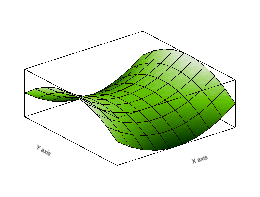Mountain saddle

A saddle is a mountain pass in a gently curved environment.
geomorphology

The term mountain saddle is derived from the comparable shape of the riding saddle . Geometrically, the saddle point is a smooth, flat point of a monotonically increasing function (S-shape). In the saddle area, both the ridge line and the valley path run horizontally, that is, the ridge and valley lines are locally U-shaped (the latter upside down). Mathematically exactly formulated in the saddle point the surface normal of the tangential plane is vertical, and the main curvatures have unequal signs . This geometry was also adopted as a basic landscape element in general language and as a relief element in technical language.
In addition to the notch, the saddle is one of the two basic fits: In the latter (to the notch in the blade) the valley line is (reversed) V-shaped, i.e. there is no flat surface at the pass height (see the delimitation of the back and Ridge within the term comb ). Of "saddle" and "saddle" one speaks when describing the surface shape of the word "pass" (to Latin passus , Step ',' Mountain transition ') avoids this regard so far, because not every pass is wegbar and transport links, the actual pass does not have to run past the lowest point. Otherwise, saddle and notch are sometimes used as the respective generic term for each other: This is also how one speaks of notch height in relation to a saddle . When viewed on the smallest scale, even notches have a (geometrically) flat saddle point, except in extreme rocky terrain, which means that saddle can also be used as a generic term. In terms of landscape, a saddle can generally be seen as flatter than a saddle, with a flowing demarcation depending on the regional frequency. Compared to the notch, “saddle” as a word also implies the broader term of the pass landscape surrounding the actual pass height .
The saddle and notch are the most common forms: If the ridge line is V-shaped, one speaks of a notch (cf. Kerbtal ) or also of a notch (ridge, ridge notch) . This form only occurs in harder rock, otherwise the erosion usually rounds off the saddle point, at least on a small scale. There are also numerous mixed and special forms .
Orography
The ridge line on which the mountain saddle lies is always a watershed per se .
Name customer
Saddle comes from Old High German satul . It is certainly of Germanic origin ( English saddle ), and its meaning is close to the Latin sedes 'seat', German armchair . The word could be an early borrowing from another Indo-European language , there is also Latin sedile or Slavic sedlo - as a toponym, also alive. In any case, the meaning was limited to the riding saddle from an early stage, and so it retains the transferred meaning of the rounded saddle-shaped in contrast to other similar forms.
In general, saddle is the general word for pass in the flat and medium mountainous landscapes, while Scharte is reserved for the mountains throughout. A more precise demarcation between passes called “Sattel” and “Scharte” can be found where both basic forms occur and other passport names (such as Joch , Törl , Gscheid, etc.) are missing.
Individual evidence
- ↑ a b cf. about Herbert Louis, Klaus Fischer: General Geomorphology. Volume 2 picture part . 4th edition. Verlag Walter de Gruyter, 1979, ISBN 978-3-11-007103-0 ( textbook series of general geography , Erich Obst, ISSN 0458-9815 ), Fig. 125 Transfluence pass and map terrace in the Radstätter Tauern, Eastern Alps , p. 127 f ( limited preview in Google Book Search) - pictures of typical glacier saddles before and after too.
- ↑ Landforms . (PDF) alpenverein.at, OeAV training documents, p. 2.
- ↑ a b Otto Lanser: Pass names in the Alps. In: Publications of the Tiroler Landesmuseum Ferdinandeum. 31, 1951, Sattel , p. 493 f. Scharte , p. 495 ( PDF on ZOBODAT , entire article p. 493–500, there p. 1 and 3 respectively).
- ↑ Pass, yoke or saddle? SRF Wissen , March 13, 2014 (accessed June 9, 2015).
- ↑ a b c d saddle , m. ephippium . In: Jacob Grimm , Wilhelm Grimm : German Dictionary . Hirzel, Leipzig 1854–1961 ( woerterbuchnetz.de , University of Trier).
- ↑ "Scharte" for mobile passes is rare. Lanser 1951 names the Arlscharte and the Sölkscharte .